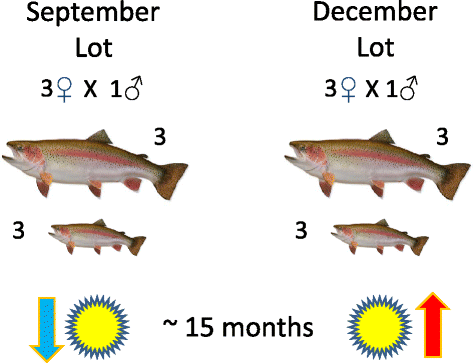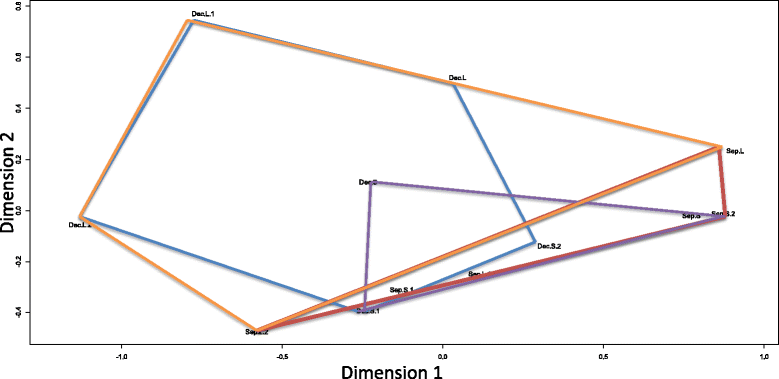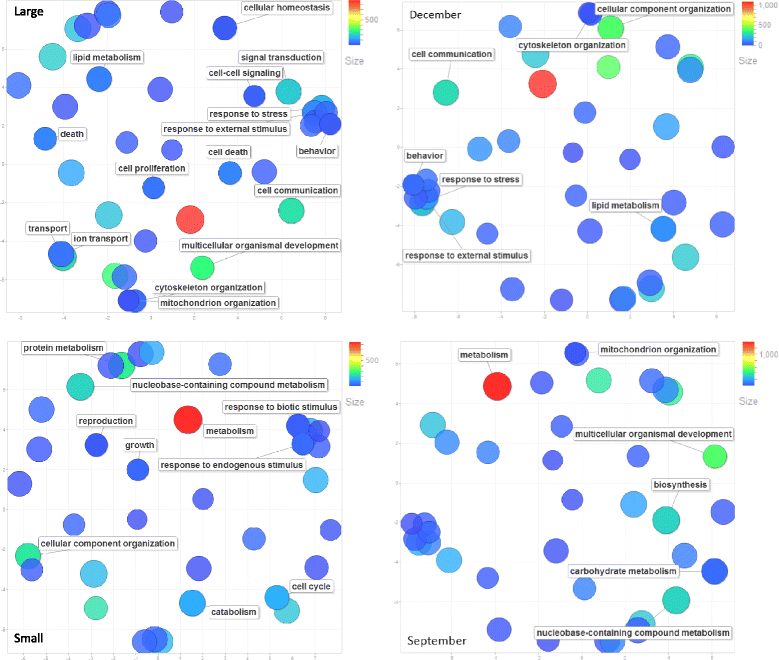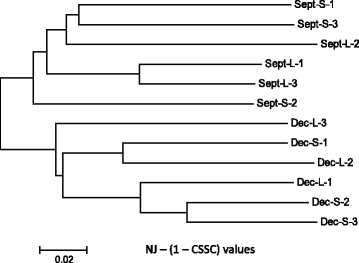Transcriptome profiling in fast versus slow-growing rainbow trout across seasonal gradients
- PMID: 26768650
- PMCID: PMC4714434
- DOI: 10.1186/s12864-016-2363-5
Transcriptome profiling in fast versus slow-growing rainbow trout across seasonal gradients
Abstract
Background: Circannual rhythms in vertebrates can influence a wide variety of physiological processes. Some notable examples include annual reproductive cycles and for poikilotherms, seasonal changes modulating growth. Increasing water temperature elevates growth rates in fishes, but increases in photoperiod regime can have similar influences even at constant temperature. Therefore, in order to understand the dynamics of growth in fish it is important to consider the background influence of photoperiod regime on gene expression differences. This study examined the influence of a declining photoperiod regime (winter solstice) compared to an increasing photoperiod regime (spring equinox) on white muscle transcriptome profiles in fast and slow-growing rainbow trout from a commercial aquaculture strain.
Results: Slow-growing fish could be characterized as possessing transcriptome profiles that conform in many respects to an endurance training regime in humans. They have elevated mitochondrial and cytosolic creatine kinase expression levels and appear to suppress mTOR-signaling as evidenced by elevated TSC2 expression, and they also have elevated p53 levels. Large fish display a physiological repertoire that may be consistent with strength/resistance physiology having elevated cytoskeletal gene component expression and glycogen metabolism cycling along with higher PI3K levels. In many respects small vs. large fish match eccentric vs. concentric muscle expression patterns, respectively. Lipid metabolic genes are also more elevated in larger fish, the most notable being the G0S2 switch gene. M and Z-line sarcomere remodelling appears to be more prevalent in large fish. Twenty-three out of 26 gene families with previously reported significant SNP-based growth differences were detected as having significant expression differences.
Conclusions: Larger fish display a broader array of genes showing higher expression, and their profiles are more similar to those observed in December lot fish (i.e., an accelerated growth period). Conversely, small fish display gene profiles more similar to seasonal growth decline phases (i.e., September lot fish). Overall, seasonal timing was coupled to greater differences in gene expression compared to differences associated with fish size.
Figures






Similar articles
-
Differential gene expression in small and large rainbow trout derived from two seasonal spawning groups.BMC Genomics. 2014 Jan 22;15:57. doi: 10.1186/1471-2164-15-57. BMC Genomics. 2014. PMID: 24450799 Free PMC article.
-
Impact of Thermal Stress on Kidney-Specific Gene Expression in Farmed Regional and Imported Rainbow Trout.Mar Biotechnol (NY). 2015 Oct;17(5):576-92. doi: 10.1007/s10126-015-9640-1. Epub 2015 May 28. Mar Biotechnol (NY). 2015. PMID: 26017776
-
Effects of sustained swimming on the red and white muscle transcriptome of rainbow trout (Oncorhynchus mykiss) fed a carbohydrate-rich diet.Comp Biochem Physiol A Mol Integr Physiol. 2013 Nov;166(3):510-21. doi: 10.1016/j.cbpa.2013.08.005. Epub 2013 Aug 19. Comp Biochem Physiol A Mol Integr Physiol. 2013. PMID: 23968867
-
Iron-sulfur cluster scaffold (ISCU) gene is duplicated in salmonid fish and tissue and temperature dependent expressed in rainbow trout.Gene. 2013 Jan 10;512(2):251-8. doi: 10.1016/j.gene.2012.10.037. Epub 2012 Nov 5. Gene. 2013. PMID: 23137639
-
Revisiting the Teleost Thymus: Current Knowledge and Future Perspectives.Biology (Basel). 2020 Dec 25;10(1):8. doi: 10.3390/biology10010008. Biology (Basel). 2020. PMID: 33375568 Free PMC article. Review.
Cited by
-
Muscle Transcriptome Sequencing Revealed Thermal Stress-Responsive Regulatory Genes in Farmed Rohu, Labeo rohita (Hamilton, 1822).Mar Biotechnol (NY). 2023 Dec;25(6):1057-1075. doi: 10.1007/s10126-023-10259-8. Epub 2023 Oct 25. Mar Biotechnol (NY). 2023. PMID: 37878212
-
The Effect of Continuous Light on Growth and Muscle-Specific Gene Expression in Atlantic Salmon (Salmo salar L.) Yearlings.Life (Basel). 2021 Apr 10;11(4):328. doi: 10.3390/life11040328. Life (Basel). 2021. PMID: 33920077 Free PMC article.
-
Multi-trait GWAS for growth under contrasting thermal rearing conditions in rainbow trout (Oncorhynchus mykiss).Mol Genet Genomics. 2025 Aug 11;300(1):75. doi: 10.1007/s00438-025-02263-5. Mol Genet Genomics. 2025. PMID: 40788500
-
Co-expression Analysis of Sirtuins and Related Metabolic Biomarkers in Juveniles of Gilthead Sea Bream (Sparus aurata) With Differences in Growth Performance.Front Physiol. 2018 Jun 5;9:608. doi: 10.3389/fphys.2018.00608. eCollection 2018. Front Physiol. 2018. PMID: 29922168 Free PMC article.
-
Mustn1 ablation in skeletal muscle results in functional alterations.FASEB Bioadv. 2023 Nov 15;5(12):541-557. doi: 10.1096/fba.2023-00082. eCollection 2023 Dec. FASEB Bioadv. 2023. PMID: 38094159 Free PMC article.
References
-
- Hosn WA, Dutilleul P, Boisclair D. Use of spectral analysis to estimate short-term periodicities in growth rates of brook trout Salvelinus fontinalis. Can J Fish Aquat Sci. 1997;54:1532–41. doi: 10.1139/f97-060. - DOI
-
- Boeuf G, Le Bail PY. Does light have an influence on fish growth? Aquaculture. 1999;177:129–52. doi: 10.1016/S0044-8486(99)00074-5. - DOI
-
- Farbridge KJ, Leatherland JF. Lunar cycles of coho salmon, Oncorhynchus kisutch. I. Growth and feeding. J Exp Biol. 1987;129:165–78. - PubMed
-
- Takemura A, Rahman MS, Nakamura S, Park YJ, Takano K. Lunar cycles and reproductino activity in reef fishes with particualr attention to rabbitfishes. Fish Fish. 2004;5:317–28. doi: 10.1111/j.1467-2679.2004.00164.x. - DOI
Publication types
MeSH terms
Substances
LinkOut - more resources
Full Text Sources
Other Literature Sources
Research Materials
Miscellaneous

